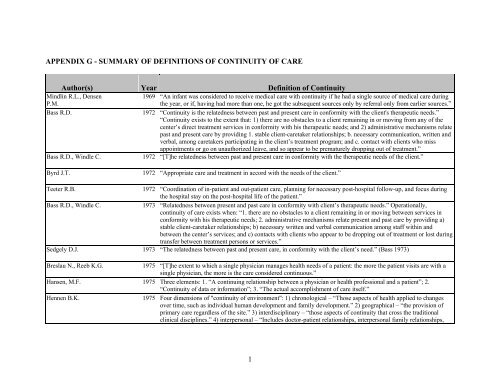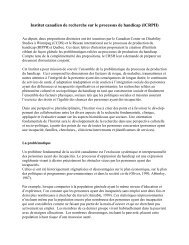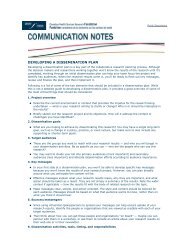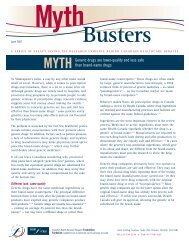Summary of Definitions of Continuity of Care
Summary of Definitions of Continuity of Care
Summary of Definitions of Continuity of Care
You also want an ePaper? Increase the reach of your titles
YUMPU automatically turns print PDFs into web optimized ePapers that Google loves.
APPENDIX G - SUMMARY OF DEFINITIONS OF CONTINUITY OF CAREAuthor(s) Year Definition <strong>of</strong> <strong>Continuity</strong>Mindlin R.L., DensenP.M.Bass R.D.Bass R.D., Windle C.1969 “An infant was considered to receive medical care with continuity if he had a single source <strong>of</strong> medical care duringthe year, or if, having had more than one, he got the subsequent sources only by referral only from earlier sources.”1972 “<strong>Continuity</strong> is the relatedness between past and present care in conformity with the client's therapeutic needs.”“<strong>Continuity</strong> exists to the extent that: 1) there are no obstacles to a client remaining in or moving from any <strong>of</strong> thecenter’s direct treatment services in conformity with his therapeutic needs; and 2) administrative mechanisms relatepast and present care by providing 1. stable client-caretaker relationships; b. necessary communication, written andverbal, among caretakers participating in the client’s treatment program; and c. contact with clients who missappointments or go on unauthorized leave, and so appear to be prematurely dropping out <strong>of</strong> treatment.”1972 “[T]he relatedness between past and present care in conformity with the therapeutic needs <strong>of</strong> the client.”Byrd J.T.1972 “Appropriate care and treatment in accord with the needs <strong>of</strong> the client.”Teeter R.B.1972 “Coordination <strong>of</strong> in-patient and out-patient care, planning for necessary post-hospital follow-up, and focus duringthe hospital stay on the post-hospital life <strong>of</strong> the patient.”Bass R.D., Windle C.1973 “Relatedness between present and past care in conformity with client’s therapeutic needs.” Operationally,continuity <strong>of</strong> care exists when: “1. there are no obstacles to a client remaining in or moving between services inconformity with his therapeutic needs; 2. administrative mechanisms relate present and past care by providing a)stable client-caretaker relationships; b) necessary written and verbal communication among staff within andbetween the center’s services; and c) contacts with clients who appear to be dropping out <strong>of</strong> treatment or lost duringtransfer between treatment persons or services.”Sedgely D.J. 1973 “The relatedness between past and present care, in conformity with the client’s need.” (Bass 1973)Breslau N., Reeb K.G.1975 “[T]he extent to which a single physician manages health needs <strong>of</strong> a patient: the more the patient visits are with asingle physician, the more is the care considered continuous.”Hansen, M.F. 1975 Three elements: 1. “A continuing relationship between a physician or health pr<strong>of</strong>essional and a patient”; 2.“<strong>Continuity</strong> <strong>of</strong> data or information”; 3. “The actual accomplishment <strong>of</strong> care itself.”Hennen B.K.1975 Four dimensions <strong>of</strong> "continuity <strong>of</strong> environment": 1) chronological – “Those aspects <strong>of</strong> health applied to changesover time, such as individual human development and family development.” 2) geographical – “the provision <strong>of</strong>primary care regardless <strong>of</strong> the site.” 3) interdisciplinary – “those aspects <strong>of</strong> continuity that cross the traditionalclinical disciplines.” 4) interpersonal – “Includes doctor-patient relationships, interpersonal family relationships,1
Author(s) Year Definition <strong>of</strong> <strong>Continuity</strong>and interpr<strong>of</strong>essional relationships.”McWhinney I.R.1975 <strong>Continuity</strong> <strong>of</strong> care in family practice: “is not delineated by the nature <strong>of</strong> the disease” and is a “continuity <strong>of</strong> personalresponsibility”, “terminated only by death, by mutual agreement, or by decision <strong>of</strong> one <strong>of</strong> the parties.”Amyot A., Lavoie J.G. 1976 [Commitment to the patient and his/her changing needs regardless <strong>of</strong> site <strong>of</strong> care; can only be provided by a team –that acts as a substitute mother. Preferably team should be assigned on a geographic basis to be able to transcendorganizational barriers.] [Fr.]Breslau N., Haug M.R. 1976 “<strong>Continuity</strong> <strong>of</strong> seeing one’s ‘own’ physician.” “ The extent to which pediatric care was given to a family by a single(‘own’) pediatrician.”McGuire H.D. 1976 “…[A]n uninterrupted succession <strong>of</strong> care, a planned effort on the part <strong>of</strong> providers to assure patients continuity <strong>of</strong>services, if not by the same individual on all occasions, at least by health pr<strong>of</strong>essionals who are familiar with thepatient’s condition and treatment program. This also implies uninterrupted succession when the patient’s needsrequire a transfer to another source <strong>of</strong> care…”Shortell S.M.1976 “<strong>Continuity</strong> <strong>of</strong> medical care can be defined as the extent to which medical care services are received as acoordinated and uninterrupted succession <strong>of</strong> events consistent with the medical care needs <strong>of</strong> patients.” Underlyingtraits implied by the definition include: “1) the extent to which the provider seen for the first visit is also seen in thenext and subsequent visits; 2) the extent to which broken appointments, whether due to provider or patient, areminimized; 3) the extent to which duplication <strong>of</strong> tests, examinations, history taking, and procedures is minimized;4) the extent to which appropriate follow-up care, including patient compliance, is maximized; and 5) the extent towhich medical care can be received in a single location.”Starfield B.H., SimborgD.W., Horn S.D., et al.Bice, T.W.,Boxerman, S.B.Shorr G.I., NuttingP.A.Shortell S.M.,Richardson W.C.,LoGerfo J.P., et al.Starfield B., SimborgD., Johns C., et al.1976 <strong>Continuity</strong> <strong>of</strong> medical record: “having the patient seek care from the same facility.”<strong>Continuity</strong> <strong>of</strong> practitioner: “patients saw the same physician on repeated visits.”1977 <strong>Continuity</strong> if care is “the extent to which a given individual’s total number <strong>of</strong> visits for an episode <strong>of</strong> illness <strong>of</strong> aspecific time period are with a single or group <strong>of</strong> providers.”1977 Transition rates <strong>of</strong> the population among critical elements <strong>of</strong> the process. Primary prevention to secondaryprevention to intervention. Specific illness, care process (succession <strong>of</strong> events over time), not provider specific.1977 “Number <strong>of</strong> different contact points (e.g., emergency room, physician’s <strong>of</strong>fice, outpatient clinic, etc.) for receivingcare out <strong>of</strong> total number <strong>of</strong> contact points available… . The two percentages are standardized to take into accountdifferences in the denominator. The scoring is then reversed by subtracting from 100 so that the higher numberindicates greater continuity.”1977 <strong>Continuity</strong> <strong>of</strong> practitioner: “When the same practitioner saw the patient on follow-up.”2
Author(s) Year Definition <strong>of</strong> <strong>Continuity</strong>Hinman E.J.1978 3 elements for a continuity <strong>of</strong> care system: “first, there must be an organized system within which the care isprovided; second, there must be providers with the training and motivation to assure that the proper care is given(the principal provider <strong>of</strong> this care will be the primary physician); and third, there must be extensive patientinvolvement in the delivery process.”Cook, R.L.1979 “<strong>Continuity</strong> involves (1) patient participation in the planning, implementation, evaluation, and revision <strong>of</strong> hi/hernursing care based on reliable information; and (2) the continuous flow <strong>of</strong> relevant information about the patientbetween appropriate health-team members.”Hadac R.R., SmithC.K., Gordon M.J.1979 “<strong>Continuity</strong> <strong>of</strong> medical care can be defined as the extent to which medical care services are received as acoordinated and uninterrupted succession <strong>of</strong> events consistent with the medical care needs <strong>of</strong> patients.” (Shortell)Pereira Gray D.J.1979 Distinguishes between "personal" and "continuous" care. Personal refers to trusting and committed relationship.Continuous care refers to seeing same physician over time.Rosenthal J.M., Miller1979 “Effective inter-institutional communication.”D.B.Steinwachs D.M.1979 “Provider continuity” is “the extent to which individuals only one provider for their medical care.”Test M.A.Davis M.Z.Horan M.J., Steinwachs D.M.,Smith C.R., et al.Patten R.C., FribergR.1979 Dimensions <strong>of</strong> continuity: 1. “Cross-sectional care” – “at any given point in a chronically mentally ill person’streatment, the person must be involved in a system <strong>of</strong> care that is comprehensive (in meeting unmet needs) andintegrated.” 2. “Longitudinal continuity” – “care that is continuous and integrated over time.”1980 <strong>Continuity</strong> <strong>of</strong> care refers to “the integration over time <strong>of</strong> staff and patient information and actions directed towardfurthering the physical and social-psychological rehabilitation <strong>of</strong> the patient, beginning in the hospital andcontinuing after discharge.”1980 “The receipt <strong>of</strong> coordinated and uninterrupted health care services.”1980 Several definitions: 1. “Seeing the same physician over a period <strong>of</strong> time.” 2. “Receiving care in the same locationand having a single medical record.” 3. “The number <strong>of</strong> physicians seen in a single spell <strong>of</strong> illness.” 4. “The rate <strong>of</strong>complete immunization, the number <strong>of</strong> hospitalizations supervised by the regular provider.” 5. “The number <strong>of</strong>family members seeing the same physician.”Phillips W.R., Little T.L. 1980 “All visits with their own family physician.”Rogers J., Curtis P.1980 Model <strong>of</strong> <strong>Continuity</strong> includes: 1. Elements – Provider (“physicians and nurses, paramedical workers, socialworkers, etc.”) Consumer (“individuals, nuclear families and even larger cohorts <strong>of</strong> people (schools, industrialunits, etc.”) Medical interaction (direct – “May occur visually, verbally, or by the written word i.e., face-to-face,through the telephone or via medical records, messages, etc.”; indirect – “uses the same communication method but3
Author(s) Year Definition <strong>of</strong> <strong>Continuity</strong>is undertaken by an intermediary, i.e., a mother discussion her absent child’s problem with a nurse, or a nursegiving the physician a message from a patient.”; 2. Knowledge Base – “The consumer element does not usuallypossess recorded prior knowledge about the provider, but may have unrecorded first or secondhand knowledgeabout this person (i.e., a physician’s reputation for kindness, medical skill, willingness to do home visits, etc.).”“The provider will usually have some recorded knowledge concerning the summer – medical records, hospitalsummaries, laboratory tests and correspondence (i.e., the script <strong>of</strong> direct and indirect encounters between thecontinuity elements). In addition the provider may have considerable unrecorded knowledge from multiple sources,both first and secondhand. The completeness and use <strong>of</strong> this knowledge has direct implications on the quality andlevel <strong>of</strong> continuity” 3. <strong>Continuity</strong> Environment – Hennen’s dimensions: “chronological, geographical,interdisciplinary, relationship, informational, accessibility and stability.”Roos L.L., Roos N.P.,Gilbert P., et al.Starfield B.Bachrach, L.Banahan Jr. B.F.,Banahan B.F.Breslau N., et al.1980 Multiple definitions: 1. “The extent to which medical services are received as a succession <strong>of</strong> coordinated anduninterrupted events.” 2. “<strong>Care</strong> received by a patient from a single physician (provider continuity).” 3. “<strong>Care</strong>received from multiple but related physicians such as those practicing as a group (site continuity).” 4. “<strong>Care</strong> linkedby a referral (Referral continuity).”1980 Longitudinality: “<strong>Care</strong> over time regardless <strong>of</strong> the presence <strong>of</strong> specific pathology.” Implies regular source <strong>of</strong> careand use <strong>of</strong> regular source <strong>of</strong> care over time. <strong>Continuity</strong>: “the way in which information about diagnosis andmanagement <strong>of</strong> a problem is conveyed from one visit to the next.”1981 “<strong>Continuity</strong> <strong>of</strong> care may be understood as a process involving the orderly, uninterrupted movement <strong>of</strong> patientsamong the diverse elements <strong>of</strong> the service delivery system.” Dimensions <strong>of</strong> continuity: temporal (longitudinal),individual (patient-centred), cross-sectional (comprehensive), flexibility (not a linear progression), relationship(between patient and providers), accessibility, and communication (between patient and providers)1981 “<strong>Continuity</strong> <strong>of</strong> care is a phenomenon that exists when (1) the patient perceives a dependency on the physician formedical care, and (2) the physician perceives a responsibility for the patient’s medical care.”1981 “[C]ontinuous care from the same physician.”Dietrich, A.J., Olson,A.L.Dorsky D.L., Housley C.E.Joseph B., Ryan C.F., BoudrealtT.M.M.A., Rice C.A.1981 “A continuing relationship with a personal physician.”1981 “To provide a patient’s transfer protocol and shared service agreement delineating the cooperation between the twoinstitutions in order to facilitate and insure efficient and effective patient care.”1981 “Passage <strong>of</strong> patients from inpatient to community care.”1981 “Continuous care by one provider.”4
Author(s) Year Definition <strong>of</strong> <strong>Continuity</strong>Wall E.M.1981 Multiple definitions: 1. “Personal responsibility neither limited by the nature <strong>of</strong> the illness nor by the time spentwith the patient.” 2. “The extent to which services are received as part <strong>of</strong> a coordinated and uninterruptedsuccession <strong>of</strong> events consistent with the medical care needs <strong>of</strong> patients.” 3. “The expectation <strong>of</strong> an enduringrelationship.” 4. “The amount <strong>of</strong> prior knowledge possessed by the elements (consumers and providers) involved inmedical care.” 5. “A process variable that accounts in part for the relationship between system organization andphysician utilization.” 6. “The extent to which a single physician manages the health needs <strong>of</strong> a patient.”Breslau N. 1982 “Continuous care from a single physician.”Dietrich A.J., MartonK.I.McWhinney I.Nassif D., Garfink C.,Greenfield C.Eriksson E.A.,Mattsson L.Fletcher R.H., O'Malley M.S.,Earp J, et al.Honovich D.Ejlertsson G., Berg S.Fletcher R.H.,O'Malley M.S.,Fletcher S.W., et al.Freeman G.K.1982 “Ongoing care from a person (such as a physician or other health pr<strong>of</strong>essional) or from an institution (such as ahealth maintenance organization, hospital, or clinic).”1982 Hennen’s four dimensions <strong>of</strong> the “continuity environment”: “chronological, geographic, interdisciplinary, andinterpersonal.” Rogers and Curtis’ model <strong>of</strong> continuity includes Hennen’s dimensions, as well as: “informational,accessibility, and stability dimensions”.1982 “Structural continuity”: “pertains to the site <strong>of</strong> medical encounter and the way in which the delivery <strong>of</strong> services isorganized”. This definition assumes “that patients who receive all routine and nonemergent, nonroutine care at onesite are more likely to been seen by one physician or team <strong>of</strong> health care workers, and will, at least, have anintegrated medical record.” “Process continuity”: “the coordinated delivery <strong>of</strong> care over a period <strong>of</strong> time orthroughout an illness episode".1983 “The extent to which the same provider is seen during a sequence <strong>of</strong> visits.”1983 Strength <strong>of</strong> belief in the following statement, “You should see the same doctor on every visit.”1983 “Taking responsibility for your patients after discharge from your facility.”1984 “Seeing one's own physician on all visits.”1984 “Percent <strong>of</strong> all visits to the primary care physician.” Coordination is defined as “written evidence that the otherphysician was aware <strong>of</strong> the primary physician’s involvement, and that 1) the primary physician arranged visit to theother physician or knew about it beforehand; or 2) the primary physician was aware <strong>of</strong> the patient’s visit to theother physician after the visit.”1984 Personal/longitudinal continuity: “where one doctor may look after the same patient for many years ‘acrosssignificant life cycle changes <strong>of</strong> the patient.’”5
Author(s) Year Definition <strong>of</strong> <strong>Continuity</strong>Godkin M.A., Rice1984 “[T]he degree to which the medical care <strong>of</strong> an individual patient is provided by a single physician.”C.A.Wasson J.H., Sauvigne A.E.,Mogielnicki R.P., et al.1984 Provider continuity: “the ongoing relationship between a patient and a health care provider, independent <strong>of</strong> thepatient’s particular medical problem.”Austin E. 1985 <strong>Continuity</strong> <strong>of</strong> care is “the frequency <strong>of</strong> visit utilization.”Berg. SCoyle N., MonzilloE., Loscalzo M., et al.Ejlertsson G., Berg S.Given C.W., BransonM., Zemach R.Brody S.J.Gruppen, L.D., Wolf, F.M.,Voorhees, C.V., et al.Quartier, F.Roland M., Mayor V.,Morris R.Tessler R.C., WillisG., Gubman G.D.Torrey EFZweig S., Kruse J.,LeFevre M.1985 “In comprehensive health services organizations, the continuity dimension tends to reflect the orchestration <strong>of</strong>medical services, while in a specialized medical organization continuity usually refers to the extent to which thecare <strong>of</strong> patients is given consistently by a single physician.”1985 “<strong>Continuity</strong> <strong>of</strong> care implies a stable therapeutic relationship between patient and care provider, the care beingappropriate to the patient’s needs. Implicit in this system is a necessity for the primary health care provider toremain involved with the patient and family throughout the course <strong>of</strong> the disease.”1985 “Maintaining a long-term patient/doctor relationship, regardless <strong>of</strong> that the problem may be.”1985 Ideal continuity: “where the patient receives care from the same physician at each visit.”1986 “<strong>Continuity</strong> <strong>of</strong> care embraces all providers with as many <strong>of</strong> the services delivered in concert or separately asrequired.”1986 The physician's preference for “maintaining full responsibility for the patient’s care and only consult with aspecialist.”1986 Long-term therapeutic relationship between a patient and provider(s). [French]1986 “Identification <strong>of</strong> one doctor as the provider <strong>of</strong> primary care for an individual patient over a long period <strong>of</strong> time.”1986 3 dimensions: Discharge planning – “the transition from hospital to the community”; Successful and rapid transfer– “services which are recommended are actually received, and…delivery <strong>of</strong> services begins in a timely fashion”;Implementation <strong>of</strong> individualized service plans – “services should be consecutive and related, with clientsexperiencing few if any breaks.”1986 “A process involving the orderly, uninterrupted movement <strong>of</strong> patients among the diverse elements <strong>of</strong> the servicedelivery system.”1986 <strong>Continuity</strong> <strong>of</strong> care: “whether patients had none, some, or most prenatal care with a delivering physician.”6
Author(s) Year Definition <strong>of</strong> <strong>Continuity</strong>Bachrach, L.1987 “<strong>Continuity</strong> <strong>of</strong> care means that the patient will be able to receive all <strong>of</strong> the different services that he or she needs,even through the service system is fragmented and even though many different service delivery agencies must beinvolved in his or her treatment.” It also means that “the service system must be accessible to the patient, accessiblein many different ways” including psychological access, financial access, geographic access and access over longperiods.Freeman G.K.1987 “The patient seeing the same doctor at each visit”Mattsson L.G., Westman G. 1987 “The extent to which each individual sees only one physician.”Ruane T.J., Brody H. 1987 “<strong>Continuity</strong> <strong>of</strong> care related to those aspects <strong>of</strong> medical care outside the present time, that is past and future.” Threeelements: “Cognitive elements include the knowledge that the physician must have to provide good continuingcare.” “Management elements…include those structural aspects <strong>of</strong> the medical care system in which the physician’spractices can facilitate or hinder optimal continuing care.” The relationship elements <strong>of</strong> continuity consist <strong>of</strong>“expectations about the physician’s personal availability and responsibility.”Tessler R.C.1987 “Comprehensive discharge planning, successful and rapid transfer and implementation <strong>of</strong> the program-specifictreatment plan.”Chao J. 1988 “<strong>Continuity</strong> <strong>of</strong> care may be conceptualized as an attitude on the part <strong>of</strong> the patient and provider rather than as asuccession <strong>of</strong> visits to the same provider.”Baker F., Vischi T.1989 Seven dimensions <strong>of</strong> continuity: “1) longitudinal – client treatment matches client progress even if care givers,treatment modalities or treatment sites change; 2) individualized – client care is planned for and with particularclients and their families; 3) comprehensive – the full range <strong>of</strong> services needed by a patient are made available; 4)flexible – the services provided to a client change as that individual’s needs change; 5) personal – clients can relyon relationships with a person or persons interested in them as individuals; 6) accessible – service delivery to aclient is experienced as free <strong>of</strong> barriers; 7) informative – continuity <strong>of</strong> information exists through opencommunications between client and service providers”Beland F.1989 “A characteristic <strong>of</strong> a physician visit.” “A visit is considered to be continuous respective to past visits made to thisphysician.”Conkling V.K.1989 <strong>Continuity</strong> <strong>of</strong> care is a “coordinated multidisciplinary program to restore an ill or disabled individual to his or hermaximum capabilities in physical, mental, social, vocational and economic usefulness.”Hjortdahl, P.1989 “<strong>Continuity</strong> <strong>of</strong> care can be defined as medical care provided over time for the patient by one health care regardless<strong>of</strong> the presence <strong>of</strong> specific pathology or not.”7
Author(s) Year Definition <strong>of</strong> <strong>Continuity</strong>Kekki P. 1989 Gives several explicit definitions <strong>of</strong> continuity from Finland, Poland and Sweden.Pineault R., Lescop J.Weiss G.L., RamseyS.A.Banks N.J., Palmer R.H.Biehn J.T.Hjortdahl, P.Shegda L.M.,McCorkle R.Harding J.Herrick C.A., GoodykoontzL., Herrick R.H., et al.Hjortdahl P.,Borchgrevink C.F.Kersten D., HackenitzE.Lauria M.M.1989 Interdisciplinary or referral continuity is “the extent to which [the public and private sectors] are complementary toeach other.”1989 “An ongoing relationship between provider and patient.”1990 “The plan <strong>of</strong> care for a particular patient progresses without interruption.”1990 “<strong>Continuity</strong> <strong>of</strong> care in a teaching practice is defined as the responsibility for care undertaken by the team members,whereby patients can feel assured that their ongoing medical care will not be interrupted or compromised in the face<strong>of</strong> inevitable turnover.”1990 4 different components: “The chronological component involves the provision <strong>of</strong> patient care over time. Implicit inthis concept is accumulated knowledge about the patient…; the comprehensiveness component involves taking care<strong>of</strong> the wide array <strong>of</strong> medical problems encountered in general practice…; the personal component includes empathyand personal involvement with the patient, lasting over time, overlapping parts <strong>of</strong> the interpersonal dimension; theresponsibility component entails a longitudinal attitude and willingness to care for or coordinate the differentmedical needs <strong>of</strong> the patient.”1990 “Coordinated process <strong>of</strong> activities that involves the client and health care providers working together to facilitatethe transition <strong>of</strong> health care from one institution, agency or individual to another.”1991 “<strong>Continuity</strong> is the assurance that knowledge <strong>of</strong> the details <strong>of</strong> one patient interaction is used in subsequentinteractions.” Differentiates 8 types <strong>of</strong> continuity: hospital-hourly, hospital-daily, hospital-weekly, hospitalrecurrent,hospital-ambulatory, ambulatory-hospital, ambulatory-recurrent, ambulatory coverage.1991 Stedman’s (1982) definition: “<strong>Continuity</strong> is the absence <strong>of</strong> disruption or a succession <strong>of</strong> parts that are intimatelyunited.”1991 “Medical care over time provided by one health care worker regardless <strong>of</strong> the presence <strong>of</strong> any specific disease.”1991 “<strong>Continuity</strong> <strong>of</strong> care is the extent to which services are received as part <strong>of</strong> a coordinated and uninterruptedsuccession <strong>of</strong> events consistent with the [nursing] needs <strong>of</strong> the patients”. (Shortell)1991 “[T]he systematic assurance <strong>of</strong> uninterrupted, integrated medical and psychosocial care <strong>of</strong> patient, in accord withthe patient’s wishes, from assessment <strong>of</strong> symptoms in the prediagnostic period, throughout the phase <strong>of</strong> activetreatment, and for the duration <strong>of</strong> posttreatment monitoring and/or palliative care.”8
Author(s) Year Definition <strong>of</strong> <strong>Continuity</strong>Semke J.1991 “A process involving the orderly, uninterrupted movement <strong>of</strong> patients among the diverse elements <strong>of</strong> the servicedelivery system.” (Bachrach 1991).Barbato A., TerzianE., Saraceno B., et al.Brekke J.S., TestM.A.Hjortdahl, P.Liaw ST., Litt J.,Radford A.White D.Anderson M.A., Helms L.Bachrach L.L.Commonwealth <strong>of</strong>AustraliaFreeman G.K.,Richards S.C.Gabel L.L., LucasJ.B., Westbury R.C.1992 “A process involving the uninterrupted movement <strong>of</strong> patients over time through the diverse elements <strong>of</strong> the servicedelivery system.” (Bachrach 1991)1992 2 dimensions: “cross-sectional ‘continuity refers to the need at any one point in time for the client to be involved ina system <strong>of</strong> care that is comprehensive and integrated.’” “Longitudinal continuity means care that is continuousand integrated over time.”1992 Traditional aspect <strong>of</strong> continuity: “Medical care provided over time by one health care worker.” Revised definition<strong>of</strong> continuity: “‘A sense <strong>of</strong> overall, direct or coordinative responsibility for the different medical needs <strong>of</strong> thepatient.’”1992 Five dimensions <strong>of</strong> the continuity environment: “firstly chronological continuity, which refers to care provided overtime to a defined population (also known as longitudinal continuity); secondly geographical continuity referring tosite continuity and/or provider continuity regardless <strong>of</strong> site (<strong>of</strong>fice, hospital, home)… Thirdly interdisciplinarycontinuity or the role <strong>of</strong> the general practitioner in tackling or coordinating the undifferentiated illnesses, themultifactorial causes and the range <strong>of</strong> services available. Fourthly interpersonal or relational continuity refers tocontinuity <strong>of</strong> process that involves the quality <strong>of</strong> relationships...Informational continuity refers to the medicalrecord as well as all forms <strong>of</strong> communication between the patient and provider.”1992 Gives several definitions from the literature including: “A broad number <strong>of</strong> strategies intended to ensure long-term,comprehensive support for people with mental health problems in managing day-to-day life in the “natural milieu”or non-institutional environment.” “ The coordination <strong>of</strong> diverse services required for the treatment <strong>of</strong> any type <strong>of</strong>chronic or complex illness.”1993 “Coordinating the delivery <strong>of</strong> ongoing health care services in a variety <strong>of</strong> health care settings.” “Discharge planning[is] a means <strong>of</strong> achieving continuity <strong>of</strong> care [and] is the process in which a patient’s continuing health needs areidentified and communicated to providers at the next level <strong>of</strong> care.”1993 Canadian definition <strong>of</strong> continuity <strong>of</strong> care: “A general practitioner or family physician who, in addition to medicaltasks, takes on direct responsibility for connecting patients with the mental health service system.”1993 “<strong>Continuity</strong> <strong>of</strong> care is the provision <strong>of</strong> long-term, barrier-free access to the necessary range <strong>of</strong> mental health,general health, social and disability services.”1993 “Seeing the same doctor each time.”1993 Long-term relationship with physician. Ten domains characterise continuity from patient perspective: 1)“familiarity with physician” 2) “physician's knowledge <strong>of</strong> patient” 3) “satisfaction with care” 4) “confidence inphysician” 5) “personal attributes <strong>of</strong> physician” 6) “friendship with physician” 7) “pr<strong>of</strong>essional growth <strong>of</strong> physician9
Author(s) Year Definition <strong>of</strong> <strong>Continuity</strong>(currency <strong>of</strong> medical knowledge)” 8) “availability <strong>of</strong> physician” 9) “location <strong>of</strong> physician's <strong>of</strong>fice” 10) “ease <strong>of</strong>communication with physician.”O'Hare P.A., YostL.S., McCorkle R.Beddar, S.M., Aikin,J.L.Bostrom, J., Tisnado, J.,Zimmerman, J., et al.Brown L., Cox G.B., JonesW.E., et al.Cameron B.Freeman G.K.,Richards S.C.Holzman M.D., Elkins C.C., NeuzilD.F., et al.Shern D.L., Wilson N.Z., CoenA.S. et al.1993 “The continuity <strong>of</strong> care process is ‘…directed to the problems associated with the initial phases <strong>of</strong> the disease andto the continuing management <strong>of</strong> those not cured <strong>of</strong> the disease’. Attention to educational, psychosocial, andrehabilitation needs is part <strong>of</strong> the ongoing process <strong>of</strong> comprehensive care for patients and families. <strong>Continuity</strong> <strong>of</strong>care as a process includes cognitive, management, and relational elements.”1994 “[C]ontinuity <strong>of</strong> care is a philosophy and standard <strong>of</strong> care that involves patient, family , and health care providersworking together to provide a coordinated, comprehensive continuum <strong>of</strong> care.”1994 <strong>Continuity</strong> <strong>of</strong> nursing care: “how <strong>of</strong>ten patients are actually cared for by the same nurse during hospitalization.”1994 “A process involving the orderly, uninterrupted movement <strong>of</strong> patients among the diverse elements <strong>of</strong> the servicedelivery system” (Bachrach 1991).1994 “<strong>Continuity</strong> <strong>of</strong> care is the desired end product <strong>of</strong> the discharge process, which enables clients to maximize theirpotential for wellness in a dignified manner while minimizing discomfort and stress.”1994 Personal continuity: “seeing the same doctor”. “An on-going doctor-patient relationship built up over time.”1994 “…[W]orking with a critically ill patient and serially observing response to therapy for complex problems.”1994 “The likelihood that an individual saw a case manager, therapist or psychiatrist some time during the year and thenumber <strong>of</strong> times that this person reported being terminated from mental health care during the same period.”Spooner S.A. 1994 “[T]he extent to which same provider is seen during sequence <strong>of</strong> visits.” (Eriksson, Mattsson 1983)Volpe F. 1994 “[H]ealth care…provided in a manner that includes constant awareness <strong>of</strong> the patient’s past medical history, signs,symptoms, findings, treatments, and responses to treatments, all the while with interrelationships being seen whenthey exist.” “Being attuned to the patient’s feelings about the care provided, because a patient’s cooperation isneeded to achieve maximum continuity.”Buetow S.A.1995 “Longitudinality refers to care from the same doctor, group <strong>of</strong> doctors or facility over time, regardless <strong>of</strong> thepatient’s health problem.”Emanuel E.J., Dubler N.N. 1995 “Once established, a patient’s relationship with a competent and compassionate physician who is providing most <strong>of</strong>his or her care should endure over time.”Farrell S.P.1995 “The successful initiation and maintenance <strong>of</strong> face-t<strong>of</strong>ace contact by CSB (Community Service Board) staff withclients in state hospitals, and the provision <strong>of</strong> services post-discharge.”10
Author(s) Year Definition <strong>of</strong> <strong>Continuity</strong>Hospital Food Nutrition Focus 1995 “A component <strong>of</strong> patient care quality consisting <strong>of</strong> the degree to which the care needed by a patient is coordinatedamong practitioners and across organizations and time.”Prendergast P.J.1995 “A process that involves the orderly, uninterrupted movement <strong>of</strong> patients among the diverse elements <strong>of</strong> the servicedelivery system.” (Bachrach 1991) “<strong>Continuity</strong> <strong>of</strong> treatment refers to the maintenance <strong>of</strong> specific treatmentstrategies over time; continuity <strong>of</strong> caregivers refers to the specific relationship between the patient and the treatmentproviders; continuity <strong>of</strong> caring refers to the use <strong>of</strong> that caregiving relationship to provide longitudinal support toVivier P.M.,Lewander W.J., BlockS.H., et al.Achterberg, T.V.,Stevens, F.C.,Crebolder, H.F., et al.Alberta Association <strong>of</strong> RegisteredNursesAnsel M.G.Bell, R.vulnerable individuals.” (Harris & Bergman 1998)1995 Longitudinality is “’the presence and use <strong>of</strong> a regular source <strong>of</strong> care over time.’”<strong>Continuity</strong> is “’the means by which separate parts <strong>of</strong> (an illness) episode (either the follow-up <strong>of</strong> an acute illness orthe ongoing care <strong>of</strong> a chronic one) are joined.’”1996 “Interdisciplinary continuity can be seen as continuity in complex, multidisciplinary services. Appropriate referralsand coordination <strong>of</strong> services are examples <strong>of</strong> interdisciplinary continuity. Interpersonal continuity involves thequality and the endurance <strong>of</strong> relationships between clients and care providers. …Informational continuity refers tothe completeness <strong>of</strong> information available to and documented by care givers, thus preventing unnecessary orduplicate care or treatment.”1996 “<strong>Continuity</strong> <strong>of</strong> care is the comprehensive, coordinated, and integrated provision <strong>of</strong> appropriate health services.”1996 Cross-sectional continuity is “the comprehensiveness and level <strong>of</strong> integration <strong>of</strong> a client at any given point <strong>of</strong> timethey are involved in the community support system.” Longitudinal continuity is “care that is provided continuouslyin an integrated fashion.”1996 <strong>Continuity</strong> is provided by “having the same nurse visits the same client at the same time as <strong>of</strong>ten as possible.”Bickman L.1996 Continuum <strong>of</strong> care: “availability (and accessibility) to the full range and level <strong>of</strong> mental health services required tomeet the changing needs <strong>of</strong> children with mental health disorders.” <strong>Continuity</strong> <strong>of</strong> care: “The delivery <strong>of</strong> coordinatedservices on an individualized basis.”Escott-Stump S. 1996 “Coordination <strong>of</strong> health care activities by all disciplines within and outside the institution before admission, duringadmission, before discharge and at discharge.”Mustard C.A., MayerT., Black C., et al.O'Malley A.S., Forrest C.B.1996 <strong>Continuity</strong> <strong>of</strong> care and regular source <strong>of</strong> care: “The longitudinal characteristic <strong>of</strong> patient-provider affiliation overtime.”1996 <strong>Continuity</strong> with a community health care facility is “identification <strong>of</strong> a CHC as the site for both routine and sickcare.” <strong>Continuity</strong> with a specific clinic is “identification <strong>of</strong> a specific clinician for sick care needs.”11
Author(s) Year Definition <strong>of</strong> <strong>Continuity</strong>Owen C. 1996 “The relationship between general practitioner and patient in the long temporal axis.”Pilotto L.S.,McCallum J.,Raymond C., et al.Weiss L.J., Blustein J.Weyrauch K.F.Alegria M.,Pescosolido B.A.,Santo D., et al.Anderson M.A., Foreman M.D.,Theis S.L., et al.Castledine G.Chung R.S., Verghese J., DiazJ., et al.Elder W.G.1996 “The uninterrupted responsibility <strong>of</strong> one doctor for a patient’s care”. Dimensions that affect the quality and level <strong>of</strong>continuity (the continuity environment): “Chronological – continuity <strong>of</strong> care over time; geographical – continuity <strong>of</strong>care at different sites; interdisciplinary – holistic or specialized care; relationship – relationships with health careproviders; informational – medical information supporting continuity; accessibility – continuity improved by easyaccess to care and advice; and stability – continuity affected by stability or mobility <strong>of</strong> health care provider andpatient’s family and community”.1996 “The maintenance <strong>of</strong> enduring patient-provider relationships over a period <strong>of</strong> time.”1996 “Patients seeing their own physician versus someone else.”1997 “Single provider continuity occurs when 1) one provider is seen in three <strong>of</strong> more visits within a six month period, 2)for the same problem (as defined by the respondent) and 3) without a gap <strong>of</strong> more than two months within thatperiod unless the problem is reported to be solved.” “Multiple provider continuity occurs when 1) at least onemember in a team <strong>of</strong> providers is seen in three or more visits within a six month period, 2) for the same problem (asdefined by the respondent), 3) without a gap <strong>of</strong> more than two months within that period unless the problem isreported to be solved and 4) with an explicit referral or sharing <strong>of</strong> in formation among the providers.” “Systemcontinuity is the situation in which 1) 3 or more visits occur within a six month period, 2) for the same problem (asdefined by the respondent), 3) without a gap <strong>of</strong> more than two months within that period, 4) within the same system(public or private) <strong>of</strong> care.” “Sector continuity represents the situation where there are 1) 3 or more visits occurwithin a six month period, 2) for the same problem (as defined by the respondent), 3) without a gap <strong>of</strong> more thantwo months within that period unless the problem is reported to be solved and 4) within the same sector <strong>of</strong> care.”1997 “Involves a series <strong>of</strong> comprehensive, coordinated linkages across time, settings, providerse, and consumers <strong>of</strong>health.”1997 “<strong>Continuity</strong> suggests something which is unbroken, uninterrupted and continuous, a linkage between a sequence <strong>of</strong>events or related factor. In the case <strong>of</strong> nursing care, the expectation is that the same nurse will follow the patientthrough the key stages <strong>of</strong> his/her hospitalization or during a specific period in the community setting.”1997 “A programmatic provision for the trainee to participate in all phases <strong>of</strong> surgical experience (pre operative,operative, post operative and return follow-up).”1997 <strong>Continuity</strong> <strong>of</strong> care: “continuous relationship with a provider or clinic throughout an episode <strong>of</strong> care.” Continuum <strong>of</strong>care: “matching patient need with appropriate type and intensity <strong>of</strong> care over trajectory <strong>of</strong> illness.”12
Author(s) Year Definition <strong>of</strong> <strong>Continuity</strong>Flocke S.A.1997 “Continuous care by a physician or team over time.” “Longitudinality is defined as the length <strong>of</strong> the relationshipwith the physician.”Flocke, S.A., Stange,K.C., Zyzanski, S.J.Freeman G., HjortdahlP.Hawton K.1997 “Development <strong>of</strong> an ongoing relationship with communication, trust, and partnership with patients is a centralelement to providing quality <strong>of</strong> care.”1997 Longitudinal continuity: “<strong>Care</strong> given by one practitioner over a defined time. Personal: “an ongoing therapeuticrelationship between patient and practitioner.”1997 “Patient being seen by the same therapist for both initial assessment and subsequent treatment.”Hundley V.A., Milne J.M.,Glazener C.M. et al.Johnson S., ProsserD., Bindman J.Meijer W.J., VermeijD.J.B.Schultz A.A., Geary P.A., CaseyF.S., et al.Smith T.E., Hull J.W., Hedayat-Harris A., et al.Stewart A.L., Grumbach K.,Osmond D.H., et al.Zurek E.L.Bickman L., Salzer M.S., LambertE.W., et al.Citro, R., Ghosh S.,Churgin P.G.Forrest C.B., StarfieldB.1997 “<strong>Continuity</strong> <strong>of</strong> carer” is the same midwife “both during labour, at delivery and after delivery.”1997 Cross-sectional aspects: “continuity between service providers, comprehensiveness, and accessibility.”Longitudinal aspects: “continuity <strong>of</strong> contact (does the service stay in contact with the patient), continuity <strong>of</strong>provider, continuity through discharges and transfers, implementation <strong>of</strong> service plans.”1997 “<strong>Continuity</strong> <strong>of</strong> care implies continuity <strong>of</strong> caregiver or coordination among practitioners, among organizations, andover time.”1997 Continuum <strong>of</strong> care: “Coordinated process <strong>of</strong> activities that results when patients and health care providers worktogether to facilitate the transition from one level <strong>of</strong> care to another.” (Zarle 1989)1997 “The same clinicians provide clients with core services for the duration <strong>of</strong> their treatment in the program.”1997 “Length <strong>of</strong> time the person has been coming to the place.”1997 “Coordination <strong>of</strong> activities involving patients, providers and payers to promote the delivery <strong>of</strong> health care.”1998 Continuum <strong>of</strong> care: “availability (and accessibility) to the full range and level <strong>of</strong> mental health services required tomeet the changing needs <strong>of</strong> children with mental health disorders.” <strong>Continuity</strong> <strong>of</strong> care: “The delivery <strong>of</strong> coordinatedservices on an individualized basis.”1998 “The delivery <strong>of</strong> care in an uninterrupted and coordinated manner and in accordance with the patient's needs.”1998 A “’sustained partnership’” between patients and providers that addresses the ‘majority <strong>of</strong> a populations’ healthneeds.’” “<strong>Continuity</strong> implies that individuals use their primary source <strong>of</strong> care over time for most <strong>of</strong> their health careneeds.”13
Author(s) Year Definition <strong>of</strong> <strong>Continuity</strong>Gill J.M., Mainous1998 “Seeing the same health care provider over time.”A.G.Hill J., Sch<strong>of</strong>ield P.F.1998 “Effective hand-over procedures and clear communication between doctors.”Saarento O., ÖiesvoldT., Sytema S., et al.Sahlberg-Blom E.,Ternestedt B.M.,Johansson J.E.Smith L.L., AldersonC., Bowser J., et al.Waldenström U.,Turnbull D.AIDS Policy LawBrekke J.S., Ansel M.,Long J., et al.Chaudry R.V., Brandon W.P.,Schoeps N.B.Downing A., Hatfield B.Hecht F.M., Wilson I.B., Wu A.W.,et al.Love M.M., MainousA.G.Perrin J.M.1998 “The degree to which the service system links episodes <strong>of</strong> treatment into a seamless, uninterrupted whole, inconformity with the needs <strong>of</strong> the patient.” “<strong>Continuity</strong> <strong>of</strong> care is a multidimensional concept including integrationand coordination <strong>of</strong> services, communication among the various service providers and the stability <strong>of</strong> patientcaregiverrelationship over time.”1998 “<strong>Continuity</strong> <strong>of</strong> care means that the patient receives adequate care and treatment on a regular basis, and that thedifferent care episodes are connected in such a way that care actions occur in a similar way and the care culture isthe same. <strong>Continuity</strong> <strong>of</strong> care is partially dependent on continuity <strong>of</strong> person, and means that as few people aspossible provide the care, while continuity <strong>of</strong> care site means that the patient stays at the same place for a longerperiod <strong>of</strong> time.”1998 Continuous treatment teams: “consistent group <strong>of</strong> care providers giving on-going care in whatever setting the clientis found.”1998 “[C]ontinuity <strong>of</strong> midwifery care…[is] that provided by a midwife or small group <strong>of</strong> midwives from early pregnancyto the postnatal period.”1999 “<strong>Continuity</strong> <strong>of</strong> care – which includes not only access to medications but also to education, prevention and supportservices – is a necessity given the fact that most inmates eventually return to the communities where they lived.”1999 Longitudinal continuity – “the extent to which clients are involved in treatment continuously over time withoutgaps in service.” Service intensity – “the number <strong>of</strong> service contacts or total duration <strong>of</strong> service contacts over aspecified period.”1999 “Access to a regular doctor.”1999 “No service user is lost to services.” “There is a named key worker (case manager) who both delivers andcoordinates care.”1999 “Maintaining consistent providers over time and planning for follow-up.”1999 “A continuous long-term relationship between a physician and a patient….”1999 <strong>Continuity</strong> is an “uninterrupted connection or succession; close union <strong>of</strong> parts.”14
Author(s) Year Definition <strong>of</strong> <strong>Continuity</strong>Preston C., Cheater F., Baker R., etal.1999 “Receiving care from a particular pr<strong>of</strong>essional throughout the care process, and receiving consistent, coordinatedcare from different staff working together.”Raddish M., Horn S.D., Sharkey 1999 “Number <strong>of</strong> providers caring for a patient in a managed care setting.”P.D.Sytema S., Burgess P.1999 2 dimensions: Cross-sectional continuity is “the comprehensiveness and accessibility <strong>of</strong> services required to meetthe range <strong>of</strong> needs <strong>of</strong> long term patients.” Longitudinal continuity includes “continuity <strong>of</strong> service provision(sustained contact with services), continuity <strong>of</strong> service provider (i.e. patients receive services across time from thesame staff), and continuity through discharges and transfers (i.e. flexible and rapid transfer between care levelsWare N.C., Tugenberg T.,Dickey B., et al.Anderson M.A.,Helms L.B.Bindman J., JohnsonS., Szmulker G., et al.Biró M.A., Waldenström U.,Pannifex J.H.according to varying needs <strong>of</strong> patients).”1999 “Management and treatment <strong>of</strong> [severe conditions that are chronic and debilitating] over time.” Continuum <strong>of</strong> care:“a system <strong>of</strong> interventions with multiple components <strong>of</strong> varying intensity.”2000 “<strong>Continuity</strong> requires coordination <strong>of</strong> patient information among providers involved in an episode <strong>of</strong> care.”2000 “Perceived accessibility <strong>of</strong> services and knowledge about them, the number <strong>of</strong> keyworkers in a defined period <strong>of</strong>time, and the proportion <strong>of</strong> time out <strong>of</strong> contact with services.”2000 “<strong>Care</strong>givers committed to a shared philosophy <strong>of</strong> care or care provided by a small group throughout thechildbearing episode.”Bull M.J., Hansen H.E., Gross C.R. 2000 “Consistency <strong>of</strong> information about a patient’s illness and care management.”Cassady C.E., Starfield B.,Hurtado M.P., et al.Chien C.F., Steinwachs D.M.,Lehman A., et alCook A., Lennox N.Fleming D.M.Freeman G., SheppardS., Robinson I., et al.2000 Longitudinality: “ongoing person-focused care.”2000 <strong>Continuity</strong> <strong>of</strong> care is “longitudinal care that is integrated and coordinated over time.” Provider continuity is “seeingthe same provider…for all mental health care over time.”2000 “Established ongoing doctor patient relationship.”2000 Hennen’s 7 dimensions: “chronological (i.e. longitudinal); geographically linked (organizational); interdisciplinary(integration <strong>of</strong> care between specialties and paramedical services); relationship (between the carer and the caredfor); information (records systems); accessibility (concerned with the organization <strong>of</strong> care rather than its location);stability (refers to the stability <strong>of</strong> a particular patient’s environment).2000 A multi-aspect definition <strong>of</strong> continuity with six elements: “1.The experience <strong>of</strong> a coordinated and smoothprogression <strong>of</strong> care from the patient’s point <strong>of</strong> view (experienced continuity). To achieve this central element theservice needs: 2. Excellent information transfer following the patient (continuity <strong>of</strong> information). 3. Effective15
Author(s) Year Definition <strong>of</strong> <strong>Continuity</strong>communication between pr<strong>of</strong>essionals and services and with patients (cross-boundary and team continuity). 4. Tobe flexible and adjust to the needs <strong>of</strong> the individual patient over time (flexible continuity). 5. <strong>Care</strong> from as fewpr<strong>of</strong>essionals as possible, consistent with other needs (longitudinal continuity). 6. To provide one or more namedindividual pr<strong>of</strong>essionals with whom the patient can establish and maintain a therapeutic relationship (relational orpersonal continuity).”Freeman G.K.2000 Longitudinal continuity: “Seeing the same doctor at each contact.”Fu J.C., Lou W.Y.W.Green J.M., Renfrew M.J., CurtisP.A.Guthrie B., Wyke S.Neal R.D., Heywood P.L., MorleyS.2000 “<strong>Continuity</strong> <strong>of</strong> care describes the extent to which information about the diagnosis and management <strong>of</strong> healthproblems is conveyed from one visit to the next….This definition includes not only provider continuity but alsoother dimensions such as continuity <strong>of</strong> medical records and <strong>of</strong> geographical treatment site.”2000 <strong>Continuity</strong> <strong>of</strong> carer: “<strong>Care</strong> given by just one person.” <strong>Continuity</strong> <strong>of</strong> care: “Consistency <strong>of</strong> care from a trustedprovider.”2000 Traditionally, continuity <strong>of</strong> care has meant “a patient visits the same doctor.” Personal continuity occurs when an“ongoing doctor-patient relationship ensures that care takes account <strong>of</strong> the patient’s personal and social context.”2000 “The provision <strong>of</strong> care by one practitioner over a defined time.”Newberry P. 2000 “A continuous relationship between one physician and one patient over extended periods <strong>of</strong> time.”Roussey M., Desrues B., Turck D.,et al.Sparbel K.J.,Anderson M.A.Sturmberg J.P.Waldenström U., Brown S.,McLachlan H., et al.Donaldson M.2000 [Transfer <strong>of</strong> clinical responsibility from pediatric to adult care for very long term childhood chronic conditions e.g.Cystic Fibrosis. The success with which care is transferred depends on many factors; especially the existence <strong>of</strong> acompetent team to take care <strong>of</strong> the adult so that the patient can “separate” from trusted pediatric team to adult care.][Fr.]2000 “<strong>Continuity</strong> <strong>of</strong> care is a series <strong>of</strong> connected patient-care events both within a health care institution and amongmultiple settings. It requires coordination and linkages across time, settings, providers, and consumers <strong>of</strong> healthcare.”2000 <strong>Continuity</strong> <strong>of</strong> care “requires a stable care environment, …good communication to build a responsible doctor-patientrelationship and…the goal <strong>of</strong> achieving an improvement <strong>of</strong> the patient’s overall health.”2000 “Attendance at birth by a known caregiver.” “ <strong>Continuity</strong> <strong>of</strong> care can also mean caregivers working with a sharedphilosophy and guildelines for practice.”2001 “The degree to which health care activities are structured to increase information available to a clinician and toincrease the likelihood <strong>of</strong> goal alignment between the patient and the clinician.”16
Author(s) Year Definition <strong>of</strong> <strong>Continuity</strong>Institute <strong>of</strong> Medicine2001 “<strong>Continuity</strong> is a characteristic that refers to care over time by a single individual or team <strong>of</strong> health pr<strong>of</strong>essionals(“clinician continuity”) and to effective and timely communication <strong>of</strong> health information (about events, risks,advice, and patient preferences) (“record continuity”). It applies to both space and time. It combines events andinformation about events occurring in disparate settings, at different levels <strong>of</strong> care, and over time, preferablythroughout a person’s life span. <strong>Continuity</strong> encompasses patient and clinician knowledge <strong>of</strong> one another and theeffective and timely communication <strong>of</strong> health information that should occur among patients, their families, otherspecialists, and primary care clinicians.” (p.43)Lou W.Y.W.2001 “Describes the extent to which knowledge about the diagnosis and management <strong>of</strong> health problems is conveyedforward in time, and efficient transfer <strong>of</strong> such information between patient visits as well as providers is vital tooptimal usage <strong>of</strong> available health care resources.”Shi L., Starfield B.,2001 “Longitudinality presupposes the existence <strong>of</strong> a regular source <strong>of</strong> care and its use over time.”Xu J.Center to Improve<strong>Care</strong> <strong>of</strong> the Dying∅ Record continuity: “whether information about a patient’s history, visits, tests, allergies, medications, andpreferences are available to all clinicians who care for the patient.” Clinician continuity: “the proportion <strong>of</strong> patientvisits that are with a given ‘index’ clinician who might be identified in a variety <strong>of</strong> ways…” Site continuity: “usualsource <strong>of</strong> care.” Continuum <strong>of</strong> care: “a client-oriented system composed <strong>of</strong> both services and integratingmechanisms that guides and tracks patients over time through a comprehensive array <strong>of</strong> healthy mental health andsocial services spanning all levels <strong>of</strong> intensity <strong>of</strong> care.” Contract <strong>of</strong> attitudes: “patients’ understanding about who isin charge <strong>of</strong> their care.”17














